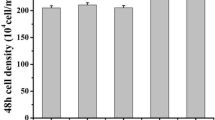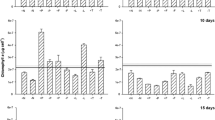Abstract
Microcystis blooms can lead to a decline in water quality and ecological damage, and pose risks to human health. Therefore, studies on the mechanisms of Microcystis colony formation and bloom occurrence are of great significance for the aquatic ecosystem. In this study, Microcystis aeruginosa was cultured with nitrate, ammonium, or urea as the nitrogen source in the medium to investigate the effects of nitrogen forms on colony formation. Nitrogen was added as a single dose or in multiple doses to determine the effect of the nitrogen supply modes on colony formation. Compared with urea, nitrate significantly stimulated the growth of M. aeruginosa while ammonium inhibited growth. Among the three nitrogen forms, ammonium resulted in the highest concentrations of total dissolved nitrogen (TDN). Colonies larger than 10 μm were significantly promoted in the ammonium treatment. Cells were generally smaller in the nitrate treatment than in the ammonium and urea treatments. The extracellular polysaccharide (EPS) contents were lower in the nitrate and urea treatments than in the ammonium treatments. Within the same nitrogen form, there was little difference in growth and colony formation between the single-dose and multiple-dose treatments. Our results demonstrated that ammonium significantly promoted M. aeruginosa colony formation, and that the nitrogen supply mode did not affect colony formation in M. aeruginosa.






Similar content being viewed by others
References
Belisle BS, Steffen MM, Pound HL, Watson SB, DeBruyn JM, Bourbonniere RA, Boyer GL, Wilhelm SW (2016) Urea in Lake Erie: organic nutrient sources as potentially important drivers of phytoplankton biomass. J Great Lakes Res 42:599–607
Berman T, Chava S (1999) Algal growth on organic compounds as nitrogen sources. J Plankton Res 21:1423–1437
Bi XD, Zhang SL, Dai W, Xing KZ, Yang F (2013) Effects of lead(II) on the extracellular polysaccharide (EPS) production and colony formation of cultured Microcystis aeruginosa. Water Sci Technol 67:803–809
Chaffin JD, Bridgeman TB (2014) Organic and inorganic nitrogen utilization by nitrogen-stressed cyanobacteria during bloom conditions. J Appl Phycol 26:299–309
Chen W, Zhang Q, Dai S (2009) Effects of nitrate on intracellular nitrite and growth of Microcystis aeruginosa. J Appl Phycol 21:701–706
Chu ZS, Jin XC, Yang B, Zeng QR (2007) Buoyancy regulation of Microcystis flos-aquae during phosphorus-limited and nitrogen-limited growth. J Plankton Res 29:739–745
Dai GZ, Shang JL, Qiu BS (2012) Ammonia may play an important role in the succession of cyanobacterial blooms and the distribution of common algal species in shallow freshwater lakes. Glob Chang Biol 18:1571–1581
de Figueiredo DR, Azeiteiro UM, Esteves SM, Goncalves FJM, Pereira MJ (2004) Microcystin-producing blooms—a serious global public health issue. Ecotoxicol Environ Saf 59:151–163
Ebina J, Tsutsui T, Shirai T (1983) Simultaneous determination of total nitrogen and total phosphorus in water using peroxodisulfate oxidation. Water Res 17:1721–1726
Fromme H, Kohler A, Krause R, Fuhrling D (2000) Occurrence of cyanobacterial toxins—microcystins and anatoxin-a—in Berlin water bodies with implications to human health and regulations. Environ Toxicol 15:120–130
Gan N, Xiao Y, Zhu L, Wu Z, Liu J, Hu C, Song L (2012) The role of microcystins in maintaining colonies of bloom-forming Microcystis spp. Environ Microbiol 14:730–742
Hyenstrand P, Burkert U, Pettersson A, Blomqvist P (2000) Competition between the green alga Scenedesmus and the cyanobacterium Synechococcus under different modes of inorganic nitrogen supply. Hydrobiologia 435:91–98
Li M, Zhu W, Gao L, Lu L (2013) Changes in extracellular polysaccharide content and morphology of Microcystis aeruginosa at different specific growth rates. J Appl Phycol 25:1023–1030
Li M, Nkrumah PN, Xiao M (2014) Biochemical composition of Microcystis aeruginosa related to specific growth rate: insight into the effects of abiotic factors. Inland Waters 4:357–362
Li M, Nkrumah PN, Peng Q (2015) Different tolerances to chemical contaminants between unicellular and colonial morph of Microcystis aeruginosa: excluding the differences among different strains. J Hazard Mater 285:245–249
Ma J, Brookes JD, Qin B, Paerl HW, Gao G, Wu P, Zhang W, Deng J, Zhu G, Zhang Y, Xu H, Niu H (2014) Environmental factors controlling colony formation in blooms of the cyanobacteria Microcystis spp. in Lake Taihu, China. Harmful Algae 31:136–142
Malvern Instruments Ltd. (2007) Mastersize 2000 User Manual
McLachlan J, Gorham PR (1962) Effects of pH and nitrogen sources on growth of Microcystis aeruginosa. Can J Microbiol 8:1–11
Medrano EA, Uittenbogaard RE, Pires LMD, van de Wiel BJH, Clercx HJH (2013) Coupling hydrodynamics and buoyancy regulation in Microcystis aeruginosa for its vertical distribution in lakes. Ecol Model 248:41–56
Mello MM, Soares MCS, Roland F, Lurling M (2012) Growth inhibition and colony formation in the cyanobacterium Microcystis aeruginosa induced by the cyanobacterium Cylindrospermopsis raciborskii. J Plankton Res 34:987–994
Monchamp ME, Pick FR, Beisner BE, Maranger R (2013) Nitrogen forms influence microcystin concentration and composition via changes in cyanobacterial community structure. PLoS One 9:e85573
Reynolds CS, Jaworski GHM (1978) Enumeration of natural Microcystis populations. Eur J Phycol 13:269–277
Rückert GV, Giani A (2004) Effect of nitrate and ammonium on the growth and protein concentration of Microcystis viridis Lemmermann (Cyanobacteria). Braz J Bot 27:325–331
Sato M, Omori K, Datta T, Amano Y, Machida M (2017) Influence of extracellular polysaccharides and calcium ion on colony formation of unicellular Microcystis aeruginosa. Environ Eng Sci 34:149–157
Shen H, Niu Y, Xie P, Tao M, Yang X (2011) Morphological and physiological changes in Microcystis aeruginosa as a result of interactions with heterotrophic bacteria. Freshw Biol 56:1065–1080
Stanier RY, Kunisawa R, Mandel M, Cohen-Bazire G (1971) Purification and properties of unicellular blue-green algae (order Chroococcales). Bacteriol Rev 35:171–205
Stolte W, McCollin T, Noordeloos AAM, Riegman R (1994) Effect of nitrogen source on the size distribution within marine phytoplankton populations. J Exp Mar Biol Ecol 184:83–97
Takamura N, Iwakuma T, Yasuno M (1987) Uptake of 13C and 15N (ammonium, nitrate and urea) by Microcystis in Lake Kasumigaura. J Plankton Res 9:151–165
Wang Y-W, Zhao J, Li J-H, Li S-S, Zhang L-H, Wu M (2011) Effects of calcium levels on colonial aggregation and buoyancy of Microcystis aeruginosa. Curr Microbiol 62:679–683
Wang W, Shen H, Shi P, Chen J, Ni L, Xie P (2016) Experimental evidence for the role of heterotrophic bacteria in the formation of Microcystis colonies. J Appl Phycol 28:1111–1123
Xiao M, Willis A, Burford MA, Li M (2017) Review: a meta-analysis comparing cell-division and cell-adhesion in Microcystis colony formation. Harmful Algae 67:85–91
Xu F, Zhu W, Xiao M, Li M (2016) Interspecific variation in extracellular polysaccharide content and colony formation of Microcystis spp. cultured under different light intensities and temperatures. J Appl Phycol 28:1533–1541
Yang Z, Kong FX (2013) Abiotic factors in colony formation: effects of nutrition and light on extracellular polysaccharide production and cell aggregates of Microcystis aeruginosa. Chin J Oceanol Limnol 31:796–802
Yang Z, Kong FX, Shi XL, Cao HS (2006) Morphological response of Microcystis aeruginosa to grazing by different sorts of zooplankton. Hydrobiologia 563:225–230
Yang Z, Kong F, Shi X, Zhang M, Xing P, Cao H (2008) Changes in the morphology and polysaccharide content of Microcystis aeruginosa (Cyanobacteria) during flagellate grazing. J Phycol 44:716–720
Zhu W, Li M, Luo Y, Dai X, Guo L, Xiao M, Huang J, Tan X (2014) Vertical distribution of Microcystis colony size in Lake Taihu: its role in algal blooms. J Great Lakes Res 40:949–955
Zhu W, Zhou X, Chen H, Gao L, Xiao M, Li M (2016) High nutrient concentration and temperature alleviated formation of large colonies of Microcystis: evidence from field investigations and laboratory experiments. Water Res 101:167–175
Wu ZX, Gan NQ, Huang Q, Song LR (2007) Response of Microcystis to copper stress: do phenotypes of Microcystis make a difference in stress tolerance? Environ Pollut 147:324–330
Funding
This study was supported by the National Natural Science Foundation of China (Grant No. 51409216) and Special Funds Projects for Control Water Pollution in Lake Taihu, Section Ten (Grant No. JSZC-G2016-198), the Fundamental Research Funds for Central Universities (Northwest A&F University, Grant No. 2452015049), the scientific research and service platform fund of Henan Province (2016151), and the funding from scientific and technological innovation team of water ecological security for Water Source Region of Mid-line of South-to-North Diversion Project of Henan Province (17454).
Author information
Authors and Affiliations
Corresponding author
Rights and permissions
About this article
Cite this article
Qu, Z., Zhao, M., Duan, P. et al. Effects of nitrogen forms and supply modes on colony formation in Microcystis aeruginosa . J Appl Phycol 30, 831–837 (2018). https://doi.org/10.1007/s10811-017-1327-8
Received:
Revised:
Accepted:
Published:
Issue Date:
DOI: https://doi.org/10.1007/s10811-017-1327-8




